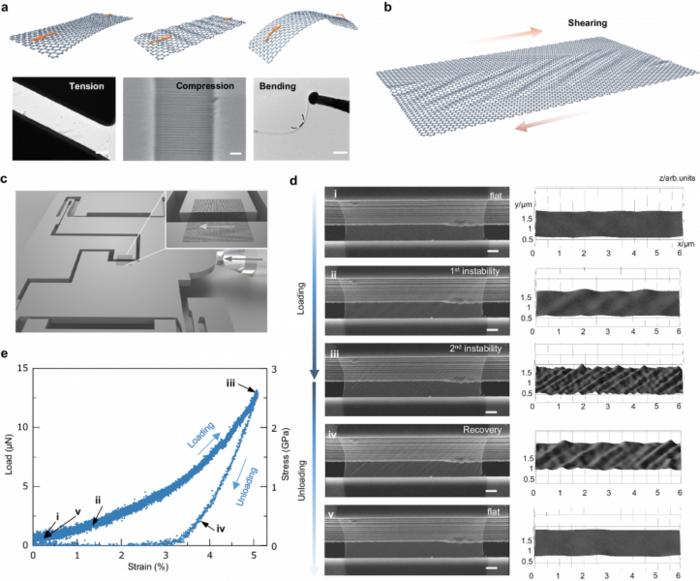Two-dimensional (2D) materials have atomic-level thickness and excellent mechanical and physical properties, with broad application prospects in fields such as semiconductors, flexible devices, and composite materials.

Credit: The University of Hong Kong
Two-dimensional (2D) materials have atomic-level thickness and excellent mechanical and physical properties, with broad application prospects in fields such as semiconductors, flexible devices, and composite materials.
Due to their extremely low bending stiffness, single-layer 2D materials will undergo out-of-plane deformation when subjected to geometric constraints, forming ripples, buckling, wrinkling, or even creases, which can significantly affect their mechanical, electrical, and thermal properties. Their mechanical stability also directly affects the lifespan and service performance of devices based on suspended 2D materials, such as micro/nanoelectromechanical systems (M/NEMS), resonators/oscillators, nano kirigami/origami, proton transport membranes, and nanochannels.
Clarifying the mechanical stability mechanisms of 2D materials and achieving overall control of their instability behaviours is crucial for the mechanical applications of 2D materials and other atomically thin films. A research team led by Professor Yang Lu from the Department of Mechanical Engineering at the University of Hong Kong (HKU) has made a significant breakthrough in this area by providing a new method for assessing instability in atomically thin films.
In collaboration with researchers from the University of Science and Technology of China, Professor Lu’s team proposed a “push-to-shear” strategy to achieve in situ observation of the in-plane shear deformation of single-layer 2D materials for the first time, achieving controllable tuning of the instability characteristics of 2D materials. Combining theoretical analysis and molecular dynamics simulations, the mechanical principles and control mechanisms of multi-order instability in atomically thin films were revealed.
The results have been published in the academic journal Nature Communications with the paper titled “Tuning Instability in Suspended Monolayer 2D Materials”.
The team is planning to collaborate with industrial partners to develop a new type of mechanical measurement platform for atomically thin films, which utilizes in-situ micro/nanomechanical techniques to achieve high-throughput mechanical property measurements while also enabling deep strain engineering of the materials’ device physical properties.
“This research breakthrough overcomes the difficulty of controlling the instability behaviour of suspended single-atom-layer 2D materials, achieving the measurement of the bending stiffness of single-layer graphene and molybdenum disulfide (MoS2). The study also provides new opportunities for modulating the nano-scale instability morphology and physical properties of atomically thin films,” said Professor Lu.
“We developed a MEMS-based in-situ shearing device to control the instability behaviour of suspended single-layer 2D materials, which is also applicable to other atomically thin films. We further investigated the evolution of the wrinkle morphology of 2D materials induced by instability, uncovering different instability and recovery paths dominated by changes in the wavelength and amplitude of wrinkles, and providing a new experimental mechanics method for assessing the instability behaviour and bending performance of atomically thin films. In addition, the local stress/strain and curvature changes related to the instability process of 2D materials have important applications in physical and chemical fields, such as changing the electronic structure by adjusting the wrinkled morphology and establishing fast proton transport channels (see Figure 1).” Professor Lu added.
“This research has achieved controllable instability modulation of atomically thin materials represented by 2D materials. Compared to traditional tensile strain engineering, shear strain can deeply regulate the band structure of 2D materials. In the future, we will continue to advance this research and ultimately hope to achieve an integrated design of mechanics and functionality in low-dimensional materials under deep strain,” said Dr Hou Yuan, the first author of the paper and a postdoctoral fellow in Professor Lu’s group.
Media Enquiries:
Faculty of Engineering, HKU
Ms Christina Chung (Tel: 3910 3324; Email: chungmc@hku.hk) or
Ms Charis Lai (Tel: 3917 1924; Email: chariskc@hku.hk)
Journal
Nature Communications
Method of Research
Experimental study
Subject of Research
Not applicable
Article Title
Tuning instability in suspended monolayer 2D materials
Article Publication Date
13-May-2024



